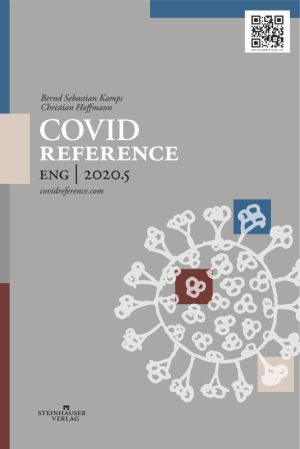Home | Daily Science: TOP 10 | TOP 10 BOOK (PDF)
By Christian Hoffmann &
Bernd S. Kamps
16 October
Special Paper
WHO Solidarity Trial Consortium, Pan, H, Peto R, et al. Repurposed antiviral drugs for COVID-19; interim WHO SOLIDARITY trial results. medRxiv 2020, posted 15 October. Full-text: https://doi.org/10.1101/2020.10.15.20209817
Will remdesivir soon join the hydroxychloroquine and lopinavir graveyard? Interim results from the Solidarity Therapeutics Trial, coordinated by the World Health Organization, indicate that remdesivir, hydroxychloroquine, lopinavir and interferon regimens appear to have little or no effect on hospitalized COVID-19, as indicated by overall mortality, initiation of ventilation and duration of hospital stay. This paper is currently being peer-reviewed.
See also the press articles in
English: Boseley S. Remdesivir has very little effect on Covid-19 mortality, WHO finds. The Guardian 2020, published 16 October. Full-text: https://www.theguardian.com/world/2020/oct/16/remdesivir-has-very-little-effect-on-covid-19-mortality-who-finds-trial-drug-coronavirus
Results from gold-standard trial described as sobering, as drug found not to improve survival rates
Spanish: Domínguez N. La OMS confirma que ninguno de los fármacos contra la covid que estaba probando salva vidas. El País 2020, published 16 October. Full-text: https://elpais.com/ciencia/2020-10-16/la-oms-confirma-que-ninguno-de-los-farmacos-contra-la-covid-que-estaba-probando-salva-vidas.html
Los datos del ensayo Solidarity confirman que ni la cloroquina ni el remdesivir ni otros dos tratamientos reducen la mortalidad.
Top 10 Special: Transmission
The 5th COVID Reference Edition will be published this month.

These are 12 among the important papers we will include in the Transmission chapter. The topics:
- Review
- Super-spreading
- Transmission terminology
- Spit happens
- Aerosolized fomites
- Fecal aerosol transmission
- Fomites
- Bus
- Leisure
- Workplace: Meat-processing plant
- Workplace: Musician
- Choir
Review
Meyerowitz EA, Richterman A, Gandhi RT, Sax PE. Transmission of SARS-CoV-2: A Review of Viral, Host, and Environmental Factors. Ann Intern Med 2020, published 17 September. Full-text: https://doi.org/10.7326/M20-5008
- Eric Meyerowitz et al. present a comprehensive review of the evidence of human SARS-CoV-2 transmission (Meyerowitz 2020). Their key points:
- Respiratory transmission is the dominant mode of transmission.
- Vertical transmission occurs rarely; transplacental transmission has been documented.
- Cats and ferrets can be infected and transmit to each other, but there are no reported cases to date of transmission to humans; minks transmit to each other and to humans.
- Direct contact and fomite transmission are presumed but are likely only an unusual mode of transmission.
- Although live virus has been isolated from saliva and stool and viral RNA has been isolated from semen and blood donations, there are no reported cases of SARS-CoV-2 transmission via fecal–oral, sexual, or bloodborne routes. To date, there is 1 cluster of possible fecal–respiratory transmission.
Super-spreading
Adam DC, Wu P, Wong JY, et al. Clustering and superspreading potential of SARS-CoV-2 infections in Hong Kong. Nat Med (2020). Full-text: https://doi.org/10.1038/s41591-020-1092-0
Dillon Adam, Peng Wu and colleagues identified 4–7 superspreading events (SSEs) across 51 clusters (n = 309 cases) and estimate that 19% (95% confidence interval, 15–24%) of cases seeded 80% of all local transmissions (Adam 2020). After controlling for age, transmission in social settings was associated with more secondary cases than households when controlling for age. Social settings are likely to become major battle grounds of coming SARS-CoV-2 waves.

Transmission terminology
Prather KA, Marr LC, Schooley RT, et al. Airborne transmission of SARS-CoV-2. Science 05 Oct 2020: eabf0521. Full-text: https://doi.org/10.1126/science.abf0521
According to Kimberly Prather and colleagues, we should clarify the terminology to distinguish between aerosols and droplets using a size threshold of 100 μm, not the historical 5 μm (Prather 2020). This size more effectively separates their aerodynamic behavior, ability to be inhaled, and efficacy of interventions. Viruses in droplets (larger than 100 μm) typically fall to the ground in seconds within 2 m of the source and can be sprayed like tiny cannonballs onto nearby individuals.
Spit happens
Bax A, Bax CE, Stadnytskyi V, Anfinrud P. SARS-CoV-2 transmission via speech-generated respiratory droplets. Lancet Inf Dis September 11, 2020. Full-text: https://doi.org/10.1016/S1473-3099(20)30726-X
Spit happens. This group published the impressive NEJM video, visualizing speech-generated oral fluid droplets and suggesting that normal speaking might be an important mode of transmission (Bax 2020). Here, the four authors vigorously resist the criticism of other authors who argued that the video experiments were unrealistic. They also provide nice new videos showing speech droplets emitted by four people, when speaking the phrase “spit happens” with the face positioned about 10–15 cm behind a thin sheet of intense green laser light.
Anfinrud P, Stadnytskyi V, Bax CE, Bax A. Visualizing Speech-Generated Oral Fluid Droplets with Laser Light Scattering. N Engl J Med. 2020 May 21;382(21):2061-2063. PubMed: https://pubmed.gov/32294341. Full-text: https://doi.org/10.1056/NEJMc2007800
New video: https://www.youtube.com/watch?v=ooVjNth4ut8

Aerosolized fomites
Asadi S, Gaaloul ben Hnia N, Barre RS, et al. Influenza A virus is transmissible via aerosolized fomites. Nat Commun 11, 4062 (2020). Full-text: https://doi.org/10.1038/s41467-020-17888-w
SARS-CoV-2 can be transmitted via droplets, fomites and possibly aerosol. Will we need to get accustomed to a fourth transmission route, aerosolized fomites? That’s what Nicole Bouvier and colleagues suggest, although for now only for influenza A virus. They show that dried influenza virus remains viable in the environment, on materials like paper tissues and on the bodies of living animals, long enough to be aerosolized on non-respiratory dust particles that can transmit infection through the air to new mammalian hosts (Asadi 2020). Will we soon see a paper about SARS-CoV-2 transmission via aerosolized fomites?
Fecal aerosol transmission
Kang M, Wi J, Yuan J, et al. Probable Evidence of Fecal Aerosol Transmission of SARS-CoV-2 in a High-Rise Building. Ann Intern Med 2020, published 1 September. Full-text: https://doi.org/10.7326/M20-0928
Nanshan Zhong, Min Kang and colleagues report 9 infected patients in 3 families. While the first family had a history of travel to the coronavirus disease 2019 (COVID-19) epicenter Wuhan, the other 2 families had no travel history and a later onset of symptoms. The families lived in 3 vertically aligned flats connected by drainage pipes in the master bathrooms. The authors suggest that virus-containing fecal aerosols may have been produced in the associated vertical stack during toilet flushing after use by the index patients (Kang M 2020). This report reminds us of a SARS-1 outbreak in March 2003 among residents of Amoy Gardens, Hong Kong, with a total of 320 SARS cases in less than three weeks (see www.SARSReference.com, page 65).
See also the comment by Michael Gormley [Gormley M. SARS-CoV-2: The Growing Case for Potential Transmission in a Building via Wastewater Plumbing Systems. Ann Intern Med 2020, published 1 September. Full-text: https://doi.org/10.7326/M20-6134] concludes that that wastewater plumbing systems, particularly those in high-rise buildings, deserve closer investigation, both immediately in the context of SARS-CoV-2 and in the long term, because they may be a reservoir for other harmful pathogens.
Fomites
Mondelli MU, Colaneri M, Seminari E, et al. Low risk of SARS-CoV-2 transmission by fomites in real-life conditions. Lancet Infect Dis September 29, 2020. Full-text: https://doi.org/10.1016/S1473-3099(20)30678-2
Some arguments that environmental contamination leading to SARS-CoV-2 transmission is unlikely to occur in real-life conditions, provided that standard cleaning procedures and precautions are enforced. The chance of transmission through inanimate surfaces is likely less frequent than hitherto recognized (Mondelli 2020).

Bus
Shen Y, Li C, Dong H. Community Outbreak Investigation of SARS-CoV-2 Transmission Among Bus Riders in Eastern China. JAMA Intern Med, September 1, 2020. Full-text: https://jamanetwork.com/journals/jamainternalmedicine/fullarticle/2770172
If you take the bus, choose seats near a window (and open it). On January 19, 2020, 68 individuals (including the source patient) took a bus on a 100-minute round trip to attend a worship event. In total, 24 (35%) received a diagnosis of COVID-19 after the event. The authors were able to identify seats for each passenger and divided bus seats into high-risk and low-risk zones (Shen Y 2020). Passengers in the high-risk zones had moderately but non-significantly higher risk of getting COVID-19 than those in the low-risk zones. On the 3-seat side of the bus, except for the passenger sitting next to the index patient, none of the passengers sitting in seats close to the bus window developed infection. In addition, the driver and passengers sitting close to the bus door also did not develop infection, and only 1 passenger sitting by an operable window developed infection. The absence of a significantly increased risk in the part of the bus closer to the index case suggested that airborne spread of the virus may at least partially explain the markedly high attack rate observed.
Leisure
Szablewski CM, Chang KT, Brown MM, et al. SARS-CoV-2 Transmission and Infection Among Attendees of an Overnight Camp — Georgia, June 2020. MMWR Morb Mortal Wkly Rep. ePub: 31 July 2020. Full-text: http://dx.doi.org/10.15585/mmwr.mm6931e1
Mid-June 2020. An overnight camp in Georgia (camp A) with trainees, staff members and campers. Wearing cloth masks for campers and opening windows and doors for increased ventilation in buildings were not required. (Cloth masks were required only for staff members.) Camp attendees engaged in a variety of indoor and outdoor activities, including daily vigorous singing and cheering. Of a total of 597 Georgia residents attendending camp A, test results were available for 344 (58%) attendees; among these 260 (76%) were positive. The overall attack rate was 44% (260 of 597), 51% among those aged 6–10 years, 44% among those aged 11–17 years, and 33% among those aged 18–21 years (Szablewski 2020). Attack rates increased with increasing length of time spent at the camp, with staff members having the highest attack rate (56%).
Workplace: Meat-processing plant
Günther T, Czech-Sioli M, Indenbirken D, et al. SARS-CoV-2 outbreak investigation in a German meat processing plant. EMBO Mol Med. 2020 Oct 4:e202013296. PubMed: https://pubmed.gov/33012091. Full-text: https://doi.org/10.15252/emmm.202013296
In June, more than 1,400 employees at a meat-processing plant (MPP) in Germany were infected with SARS-CoV-2. Now a research group led by virologist Melanie Brinkmann (Helmholtz Center for Infection Research, Braunschweig) reconstructed how the virus was transmitted in the company. The first employees who became infected worked the early shift (147 workers), mostly in a fixed position on the conveyor belt. The evaluation of these positions showed that the risk of infection was greatest within a distance of eight meters from the first infected individual (Günther 2020). In order words: a distance of 1.5 or two meters, which is currently thought (and instituted!) as relatively safe in most situations, was far from sufficient. The authors conclude that climate conditions (10° C ambient air temperature) and airflow are important factors that can promote spread of SARS-CoV-2 via distances of more than 8 meters. These findings may have far-reaching implications for pandemic mitigation strategies in industrial workplace settings.

Workplace: Musician
Plautz J. Is it safe to strike up the band in a time of coronavirus? Science, 17 July 2020. Full-text: https://www.sciencemag.org/news/2020/07/it-safe-strike-band-time-coronavirus
Is keeping 2 meters away enough to stay safe from a trumpet at full blast? Try it, find out! Introduce five student musicians – a soprano singer and clarinet, flute, French horn, and trumpet players — in a clean room one at a time and let them perform a short solo piece (Plautz 2020).
Choir
An outbreak in Sallent (72 km from Barcelona) with 30 SARS-CoV-2-infected people demonstrates the risk posed by choirs and karaoke in poorly ventilated places. See the video: https://www.youtube.com/watch?v=tuQC-NTLE54. Do not sing and jump around in enclosed spaces!

If you read Spanish, read Salas J. El peligro de cantar en interiores en tiempos de covid. El País 2020, published 26 September. Full-text: https://elpais.com/ciencia/2020-09-25/el-peligro-de-cantar-en-interiores-en-tiempos-de-covid.html. See also the City Hall announcement (in Catalan): Comunicat de l’Ajuntament de Sallent en relació als casos positius per COVID-19 de la coral The River Troupe Gospel.
